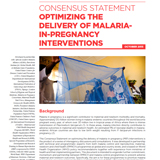
Malaria in pregnancy is a significant contributor to maternal and newborn morbidity and mortality. Approximately 125 million women living in malaria-endemic countries throughout the world become pregnant every year, of whom over 30 million live in tropical areas of Africa where there is intense transmission of Plasmodium falciparum (1). In these areas, malaria infection directly contributes to adverse outcomes in maternal and newborn health. An estimated 11% of neonatal deaths in malaria-endemic African countries are due to low birth weight resulting from P. falciparum infections in pregnancy (2).
This Consensus Statement on optimizing the delivery of malaria-in-pregnancy (MiP) interventions is the product of a series of interagency discussions and consultations. It was developed in partnership with technical and programmatic experts from both malaria control and reproductive, maternal, newborn and child health (RMNCH) programmes at global and country levels, and is based on World Health Organization (WHO) policy recommendations together with experience from ministries of health and their implementing partners. This document is intended to engender further commitment, momentum and partnership between RMNCH and malaria control programmes to prevent adverse maternal and newborn outcomes. Specifically, the aim is for these programmes to prioritize malaria in pregnancy as a core component of focused antenatal care (FANC), advocate for integrated policy-making and harmonized programme implementation, and reinforce key interventions to optimize the delivery of MiP programmes.
The impetus to produce this Consensus Statement emerged from the growing recognition that, despite clear global gains in malaria control, the delivery of MiP interventions remains suboptimal. For example, although pregnant women attend antenatal clinics at least once and often twice, only approximately 44% of women who attend antenatal clinics receive two doses of sulfadoxine-pyrimethamine for intermittent preventive treatment in pregnancy (IPTp-SP) (3), far below the target of 80%. In addition, insecticide-treated net (ITN) coverage among pregnant women is also below the global target in many countries, with the highest coverage reported in Rwanda at 72.2%, followed by Tanzania at 56.9% (4, 5). Given the devastating consequences of malaria in pregnancy, these poor coverage levels have ignited a renewed interest in improving MiP programmes by addressing missed opportunities and increasing coverage of these life-saving interventions for all pregnant women in malaria-endemic countries